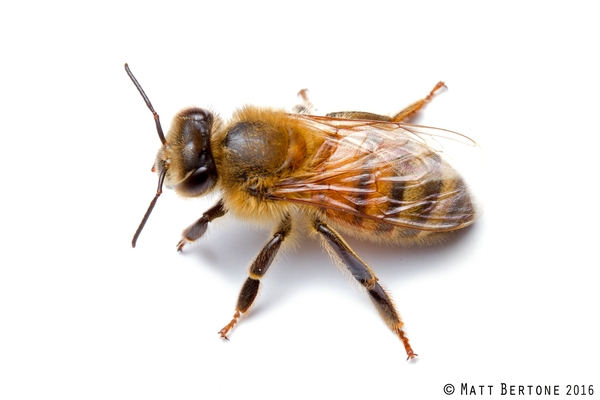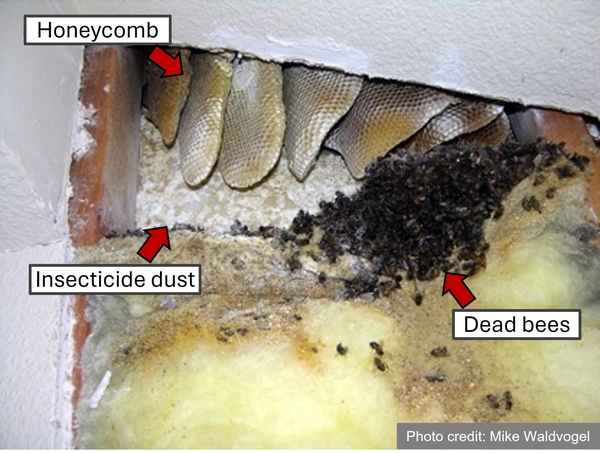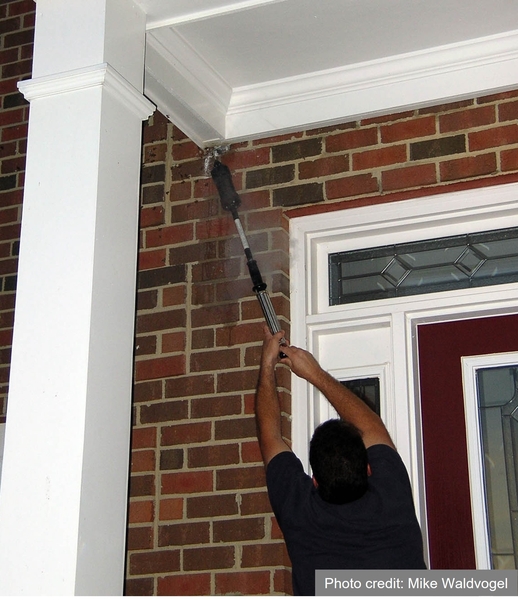Introduction
European honey bees (Apis mellifera) (Figure 1) are valuable pollinators playing an important role in both native and agricultural crop production across North Carolina and the United States. Their introduction coincided with the arrival of European settlers to North America, and today many different types of honey bees exist. Modern beekeepers keep managed colonies in wooden manufactured hives, but these social insects can also thrive in natural nesting sites - a hollow tree or other cavity. As you might guess, their preference for cavity nesting sites may place them in frequent (and unwanted) contact with home- and business owners. When this happens, it’s important to understand the options available to you for removal or management. Occasionally, honey bees may use a wall void or attic space in a building as a nesting site. In these situations, the decision to act depends upon the circumstances. Here are some simple steps we recommend for controlling honey bees nesting within a built structure.
The Bees & Your Structure
As mentioned above, honey bees are cavity nesting social insects, and built structures are full of potential nest sites. Honey bee colonies are often found residing within exterior wall and ceiling voids, where they typically establish through an external entry point (Figure 2). Honey bees reproduce by swarming where part of the old colony leaves to seek a new homesite, with this typically occurring during the months of April and May. It is possible to see bees at other times of the year, and in this case it is likely that they have been there since spring and you have just now noticed them.
- Is there any risk to my home?
Yes, there is some risk! In terms of damage, honeybees do not cause direct structural damage to buildings. They produce large amounts of hive material (wax) and store large amounts of honey over time. There may be as much as 40 pounds of honey within a wall by the end of spring. If the hive is killed the presence of stored honey, wax, and even dead bees can cause problems for home- and businessowners. Honey can continue to ferment and lead to discoloration and damage of walls, while also serving as a potential food source for other pests (ants, cockroaches, etc.). Dead bees can also serve as a potential food source and may also lead to carpet beetle infestations which can damage other natural fibers (silk, furs, etc.).
Management & Control
While some home- and businessowners may choose to coexist with their new tenants, most will want the hive removed or eradicated. It is important to note that while many commercial insecticide labels contain language prohibiting their use on plants frequented by pollinators, it is perfectly legal to use insecticides to eliminate honey bee hives that have established within built structures. Whatever your removal preferences there are several options for hive management:
Non-Lethal Removal
It is possible for beekeepers or pest management professionals to come and remove/relocate an established hive or collect a swarm present on your property before it establishes as a hive. This process is often complicated though, as the value of a single saved hive may not equal the cost of the damage to your property to remove it intact. This may include cutting large holes into ceiling and wall voids, and repair of this damage may not be included in the removal contract. It is important to fully communicate the process and fee of hive removal with your company of choice.
- Can I kick them out?
While the idea of somehow encouraging the bees to leave is a good one – in the case of honey bees, it is not an exact science. They have found the perfect place to set up their hive and have no intention of leaving, so trapping rarely results in 100% removal of bees. In fact, attempting to irritate the hive in an effort to encourage them to relocate to a trap could result in many unpleasant stings. Plugging the entrance hole is also ineffective, as the bees will search for an alternate entrance (gaps in the baseboard, outlets, vents, etc.), and may end up entering the home in the process.
Lethal Removal
Many homeowners choose their safety, peace of mind, and the preservation of their home over the life of one colony of honeybees. If this is the case for you, there are effective consumer insecticidal products which can be used, or you can rely on a professional pest management company. The most effective products for bee control are pyrethroid-based insecticide, such as 2% permethrin, which can effectively be sprayed into the void where it will contact and kill the bees directly. Other professional products exist but are only available to professional pest management companies. These products include aerosol sprays and dusts. All honey and nest products should be disposed of if the hive is treated with an insecticide as the chemicals used can contaminate the wax, pollen, and honey (Figure 2).
- How do I treat them myself?
Use an aerosol "bee and wasp" spray; the kind typically found in most lawn and garden centers or retail stores. Make sure the cannister includes a crack and crevice application tool (a straw-like attachment for the nozzle that allows you to inject the chemical into the void). Spray the chemical directly into the entrance hole during the evening hours, when most adults are likely inside. The product must contact the insects to be effective. If you are usure of the nest location try tapping the wall in the area of observed activity, listening for buzzing in response. If you are unable to reach/find an exterior entry point you can drill a 1/8 – ¼ inch access hole in the area where you believe the nest to be located and introduce the product through this hole.
When spraying overhead, protect yourself from any chemical mist that drifts down toward you by using a respirator, protective clothing, and a face shield. If you need to use a ladder to reach the nest, be extremely careful. The spray may cause the bees to fly out of the nest toward you. Wear a long-sleeved shirt and pants and a hat, if it makes you feel more confident. If the colony has been active in the wall for more than two or three weeks, consider opening the space to remove any wax and honey. Once the bees and nest material have been removed, fill the void with insulation, caulk or close off the entrance so that future swarms will not be attracted to the same cavity.
- What if I don’t want to treat them myself?
If treating the bees yourself is not something you’re comfortable with there are many professional companies able to help. In fact, some professional pest management companies specialize in non-lethal honey bee removal and relocation. Regardless, make sure you reach out directly to the company of your choosing, ask about honey bee control services, and fully understand the terms of the contract before you agree to it. Once you’re onboard with the plan, sit back, relax, and let the professionals do their job (Figure 3).
Honey bees are not the only stinging insect that may build a nest in the voids of your home or business, yellow jackets can do this as well and may be confused for honey bees by the untrained eye. For more information about bees, visit the NC State University Apiculture Program website.
We thank Stephen Bambara, J.T. Ambrose, and Mike Waldvogel for their contributions to the prior version of this article titled “Frequently Asked Questions About Removing Honey Bees from Structures – 2001”.
Publication date: June 16, 2001
Reviewed/Revised: Nov. 4, 2024
The use of brand names in this publication does not imply endorsement by NC State University or N.C. A&T State University of the products or services named nor discrimination against similar products or services not mentioned.
Recommendations for the use of agricultural chemicals are included in this publication as a convenience to the reader. The use of brand names and any mention or listing of commercial products or services in this publication does not imply endorsement by NC State University or N.C. A&T State University nor discrimination against similar products or services not mentioned. Individuals who use agricultural chemicals are responsible for ensuring that the intended use complies with current regulations and conforms to the product label. Be sure to obtain current information about usage regulations and examine a current product label before applying any chemical. For assistance, contact your local N.C. Cooperative Extension county center.
N.C. Cooperative Extension prohibits discrimination and harassment regardless of age, color, disability, family and marital status, gender identity, national origin, political beliefs, race, religion, sex (including pregnancy), sexual orientation and veteran status.



